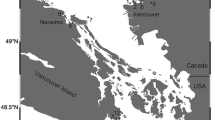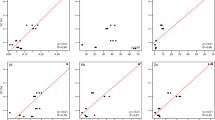Abstract
Fathead minnows (Pimephales promelas), the worm,Lumbriculus variegatus, and the amphipodsHyalella azteca andGammarus lacustris were exposed to hexachlorobenzene (HCB) in water with and without a bed of HCB-spiked sediment. Water HCB concentrations were maintained by recirculation through HCB-packed columns. Recirculating HCB-bound particulates and possibly eroded HCB particulates were an added source of HCB in addition to the sediment bed. Significant bioaccumulation of HCB in animal tissues was observed in water-only and water-sediment exposures. The presence of the HCB-spiked sediment did not result in a significant increase in the uptake of HCB by the organisms, but there was a substantial increase in sediment HCB levels over time. Higher tissue HCB levels in aquaria without sediment suggest that the sediment was a more efficient sink for HCB than the organisms.
Similar content being viewed by others
References
Adams WJ, Kimerle RA, Mosher RG (1985) Aquatic safety assessment of chemicals sorbed to sediments. In: Cardwell RD, Purdy R, Bahner RC (eds) Aquatic Toxicology and Hazard Assessment: Seventh Symposium. ASTM STP 854. American Society for Testing and Materials, Philadelphia, PA, pp 429–453
Allison LE, Moodie CD (1965) Carbonate. In: Black CA (ed) Methods of Soil Analysis. Part 2. American Society of Agronomy, Madison, WI. Monograph No. 9, p 1
American Public Health Association, American Water Works Association, Water Pollution Control Federation (1985) Standard Methods for the Examination of Water and Wastewater, 16th Ed. Washington, DC, p 700
American Society for Testing and Materials (1982) Standard test method for total and organic carbon in water oxidation by coulometric detection. D4129-82. Philadelphia, PA. pp 1–8
−American Society for Testing and Materials (1984a) Proposed new standard practice for conducting bioconcentration tests with fishes and saltwater bivalve molluscs. Draft No. 8, E47.01. Philadelphia, PA, pp 1–54
- (1984b) Annual Book of ASTM Standards. Selection 11, Volume 11.01. Philadelphia, PA. pp 371–391
Branson DR, Blau GE, Alexander HC, Neely WB (1975) Bioconcentration of 2,2′,4,4′-tetrachlorobiphenyl in rainbow trout as measured by an accelerated test. Trans Am Fish Soc 104:785–792
Bruggeman WA, Opperhuizen A, Wijbenga A, Hutzinger O (1984) Bioaccumulation of super-lilophilic chemicals in fish. Toxicol Environ Chem 7:173–189
Carlson AR, Kosian PA (1987) Toxicity of chlorinated benzenes to fathead minnows (Pimephales promelas). Arch Environ Toxicol 16:129–135
Chiou CT, Schmedding DW, Manes M (1982) Partitioning of organic compounds in octanol-water systems. Environ Sci Technol 16:4–10
Courney KD (1979) Hexachlorobenzene (HCB): A review. Environ Res 20:225–266
Ekelund R, Granmo A, Berggren M, Renberg L, Wahlberg C (1987) Influence of suspended solids on the bioavailability of hexachlorobenzene and lindane to the deposit feeding marine bivalve,Abra nitida (Müller). Bull Environ Contam Toxicol 38:500–508
Federal Register (1973) US Environmental Protection Agency, Part III, Guidelines Establishing Test Procedures for the Analysis of Pollutants, Proposed Regulations 44(233):69464–69575, Washington, DC
Giam CS, Murray HE, Ray LE, Kira S (1980) Bioaccumulation of hexachlorobenzene in killifish (Fundulus similis). Bull Environ Contam Toxicol 25:891–897
Landrum PF, Scavia D (1983) Influence of sediment on anthracene uptake, dupuration, and biotransformation by the amphipodHyalella azteca. Can J Fish Aquat Sci 40:298–305
Larsson P (1985) Contaminated sediments of lakes and oceans act as sources of chlorinated hydrocarbons for release to water and atmosphere. Nature 317:347–349
— (1986) Zooplankton and fish accumulate chlorinated hydrocarbons from contaminated sediments. Can J Fish Aquat Sci 43:1463–1466
Malueg KW, Schuytema GS, Krawczyk DF (1986) Effects of sample storage on a copper-spiked freshwater sediment. Environ Toxicol Chem 5:245–253
McQuaker NP, Kluckner PD, Chang GN (1979) Calibration of an inductively coupled plasma-atomic emission spectrometer for the analysis of environmental materials. Anal Chem 51:888–895
Muir DC, Baker BE (1976) Detection of triazine herbicides and their degradation products in tile-drain water from fields under intensive corn (maize) production. J Agric Food Chem 24:122–125
Neff JM (1984) Bioaccumulation of organic micropollutants from sediments and suspended particulates by aquatic animals. Fresenius Z Anal Chem 319:132–136
Oliver BG (1984) Uptake of chlorinated organics from anthropogenically contaminated sediments by oligochaete worms. Can J Fish Aquat Sci 41:878–883
Paterson RK (1973) Automated Pregl-Dumas technique for determining total carbon, hydrogen, and nitrogen in atmospheric aerosols. Anal Chem 65:605–609
Pavlou SP, Weston DP (1983) Initial development of alternatives for development of sediment related criteria for toxic contaminants in marine waters (Puget Sound). Phase I: Development of conceptual framework. Report submitted to U.S. Environmental Protection Agency, Region X, Seattle, WA. JRB Associates. EPA Contract No. 68-01-6388
Ripley BD, Wilkinson JW, Chau ASY (1974) Multiresidue analysis of fourteen organophosphorus pesticides in natural waters. J Assoc Offic Anal Chem 57:1033–1042
Ryan BF, Joiner BL, Ryan RA (1985) Minitab Handbook. Second Edition. Duxbury press, Boston, 379 pp
Scheele B (1980) Reference chemicals as aids in evaluating a research programme—Selection aims and criteria. Chemosphere 9:293–309
Smith PW (1979) The fishes of Illinois. University of Illinois Press, Urbana, IL., pp 141–142
Staples CA, Dickson KL, Rodgers JH Jr, Saleh FY (1985) A model for predicting the influence of suspended sediments on the bioavailability of neutral organic chemicals in the water compartment. In: Cardwell RD, Purdy R, Bahner RC (eds) Aquatic Toxicology and Hazard Assessment: Seventh Symposium. ASTM STP 854. American Society for Testing and Materials, Philadelphia, PA, pp 417–428
U.S. Environmental Protection Agency (1973) Biological field and laboratory methods for measuring the quality of surface waters and effluents. EPA/670/4-73-001. Office of Research and Development, Cincinnati, OH
— (1976) Quality criteria for water. Ammonia. Office of Planning and Standards, Washington, DC, pp 10–13
— (1979) Methods for chemical analysis of water and wastes. EPA-600/4-79-020. Environmental Monitoring and Support Laboratory, Cincinnati, OH
— (1980) Manual of analytical methods for the analysis of pesticides in humans and environmental samples. EPA-600/8-80-038. Health Effects Research Laboratory, Research Triangle Park, NC
— (1985) Ambient water quality criteria for ammonia-1985. EPA-440/5-85-001. Office of Water Regulations and Standards, Washington, DC
Author information
Authors and Affiliations
Rights and permissions
About this article
Cite this article
Schuytema, G.S., Krawczyk, D.F., Griffis, W.L. et al. Hexachlorobenzene uptake by Fathead minnows and macroinvertebrates in recirculating sediment/water systems. Arch. Environ. Contam. Toxicol. 19, 1–9 (1990). https://doi.org/10.1007/BF01059806
Received:
Revised:
Issue Date:
DOI: https://doi.org/10.1007/BF01059806




